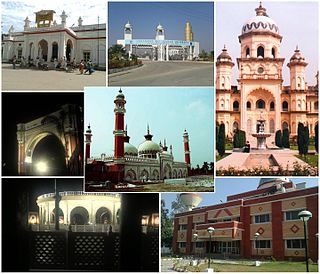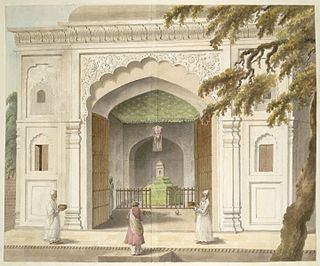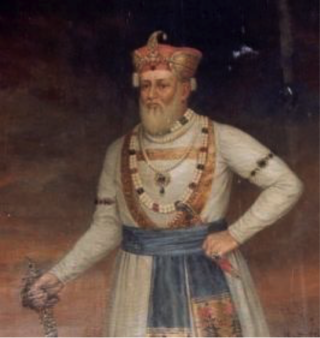Imtiyaz Ali Khan Khandara | |
|---|---|
 | |
| Born | Rampur, India |
| Occupation | |
Imtiyaz Ali Khan Khandara (1928-2018) was a painter, Marxist thinker, and art historian.
Imtiyaz Ali Khan Khandara | |
|---|---|
 | |
| Born | Rampur, India |
| Occupation | |
Imtiyaz Ali Khan Khandara (1928-2018) was a painter, Marxist thinker, and art historian.
Famously known as Master Sahab, Khan was born in Rampur, British India in 1928. He was one of the three sons of Fida Ali Khan. Fida Ali Khan was employed as a Tahseeldar in the erstwhile princely state of Rampur.Imtiyaz Ali Khan's paternal uncle was the legendary Vina player Ustad Muhammad Wazir Khan. [1] [2]
All the Naubat Khanis were fond of good food. They were able to develop their own cuisine. Rice preparations were included in their meals and Kabab featured regularly. Rakabdars from the court of Awadh were employed in their kitchens.
Naseeruddin was a Rakabdar who was employed at the house of Imtiyaz Ali Khan. He was addressed as Peerji as he shared his name with Chiragh Dilli. This family had great respect for the Sufi saint. Peerji was an expert kababiya and he came from Awadh. His father was employed with the Nawab of Rampur.
It was said that if anyone from this family doesn't take Dessert after each meal than he is not a Naubat Khani.
The preparation at their kitchens were so rich in Ingredients that once Nawab Hamid Ali Khan said that if this family was not fond of such good food they could have houses made of Gold and silver.
Imtiyaz Ali Khan has been the editor of Musaddas Tahniyat-e- Jashn-i-Benazeer. [3] He has also done extensive work on Mughal Miniatures.
Imtiyaz Ali Khan was associated with the Communist Party of India.

Awadh, known in British historical texts as Avadh or Oudh, is a historical region in northern India, now constituting the northeastern portion of Uttar Pradesh. It is roughly synonymous with the ancient Kosala region of Hindu, Buddhist, and Jain scriptures.

Rampur is a town and the municipality headquarter of Rampur District in the Indian state of Uttar Pradesh. It was formerly known for its various industries, like sugar refining and cotton milling. Its library has more than 12,000 rare manuscripts and a fine collection of Mughal miniature paintings. It is located 322 kilometres north-west of the state capital Lucknow & approx 180 kilometres from the national capital New Delhi.
Nawab is a royal title indicating a ruler, often of a South Asian state, in many ways comparable to the western title of Prince. The relationship of a Nawab to the Emperor of India has been compared to that of the Kings of Saxony to the German Emperor. In earlier times the title was ratified and bestowed by the reigning Mughal emperor to semi-autonomous Muslim rulers of subdivisions or princely states in the Indian subcontinent loyal to the Mughal Empire, for example the Nawabs of Bengal.

Rohilkhand is a region in the northwestern part of Uttar Pradesh, India, that is centered on the Bareilly and Moradabad divisions. It is part of the upper Ganges Plain, and is named after the Rohilla. The region was called Madhyadesh and Panchala in the Sanskrit epics Mahabharata and Ramayana. During the colonial era in India, the region was governed by the Royal House of Rampur.

Nawab Mirza Khan Daagh Dehlvi was a poet known for his Urdu ghazals. He belonged to the old Delhi school of Urdu poetry.

Rohillas are a community of Pashtun heritage, historically found in Rohilkhand, a region in the state of Uttar Pradesh, India. It forms the largest Pashtun diaspora community in India, and has given its name to the Rohilkhand region. The Rohilla military chiefs settled in this region of northern India in the 1720s, the first of whom was Ali Mohammed Khan.

Farrukhabad district is a district of Uttar Pradesh state of India. The town of Fatehgarh is the district headquarters. The district is part of Kanpur division.

The Rampur Raza Library located in Rampur, Uttar Pradesh, India is a repository of Indo-Islamic cultural heritage established in the last decades of the 18th century. It was built up by successive Nawabs of Rampur and is now managed by the Government of India, named after Raza Ali Khan Bahadur.
Rampur–Sahaswan gharana is a gharana of Hindustani classical music centred in the North-Uttar Pradesh towns of Rampur and Sahaswan.

The First Rohilla War of 1773–1774 was a punitive campaign by Shuja-ud-Daula, Nawab of Awadh on the behalf of Mughal Emperor, against the Rohillas, Afghan highlanders settled in Rohilkhand, northern India. The Nawab was supported by troops of the British East India Company, in a successful campaign brought about by the Rohillas reneging on a debt to the Nawab.

Nawab Faizullah Ali Khan was the first Nawab of Rampur. The princely state of Rampur was set up in year 1774, after the First Rohilla War, by the dismemberment of the Rohilla Kingdom of Rohilkhand. Faizullah Khan, the only surviving heir of Ali Mohammed Khan and opponent of the forces of Awadh and the British East India Company in the war, was installed as ruler of what was the newly created Rampur State. It bordered the Maratha Empire to the south, making it a strategic point. Under tutelage of the East India Company, Faizullah Khan ruled peacefully for 20 years. The capital Rampur was founded, and the Raza Library collection gathered.

Rampur State was a 15 gun-salute princely state of British India. It came into existence on 7 October 1774 as a result of a treaty with Oudh. Following independence in 1947, Rampur State and other princely states of the area, such as Benares and Tehri Garhwal were merged into the United Provinces. Rampur state had its capital in Rampur city and its total area was 945 sq miles. Rampur state was founded by Ali Mohammad Khan's younger son Faizullah Khan.

Nawab Ahmad Ali Khan Bahadur was Nawab of Rampur from 1794 to 1840, succeeding his brother Ghulam Muhammad Khan Bahadur. The only son of Muhammad Ali Khan Bahadur, Ahmad Ali was made Nawab following the deposition of his uncle Ghulam Muhammad by the British East India Company and the Nawab of Awadh. Ahmad Ali ruled for 46 years, although he reigned from 1794 to 1811 under a regency. He transformed the cultural fabric of Rampur and started a tradition of cultural involvement that has been maintained by his successors to the present day. In 1801, Rampur became a vassal of the HEIC following the cession of Rohilkand by the Nawab of Awadh. Ahmad Ali died on 5 July 1840, aged 52. As his only son had died young, he was succeeded as Nawab by his cousin, Muhammad Said Khan Bahadur.
Wazir Khan was a title bestowed by Mughal emperors, and may refer to:

The Second Rohilla War was a conflict between the Kingdom of Awadh and East India Company, and the Rohillas of Rampur State in 1794.

Naubat Khan was an Indian classical music composer, musician and instrumentalist who was made a Mansabdar by Mughal Emperor Akbar. He is known today for his skills with the rudra veena or bīn, which he is shown playing in paintings by Mughal court artists. Naubat Khan was the contemporary and son in law of legendary Tansen.

Ustad Mohammad Wazir Khan (1860–1926) served as the head of Arbab-e-Nishat during the period of Nawab Hamid Ali Khan of Rampur. He was also an excellent playwright who established the Rampur theatre in the building of club Ghar in Rampur.
Omrao Khan beenkar was a vina wizard of the 18th century. He was a descendant of Naubat Khan.
Ameer Khan Beenkar was an illustrious veena player of the eighteenth century. He was also an outstanding dhrupad singer. He along with his uncle and father-in-law Bahadur Hussain Khan established the Rampur musical court during the period of Nawab Yusef Ali Khan and Nawab Kalbey Ali Khan. Ameer Khan went to Haj pilgrimage with Nawab Kalbey Ali Khan in the year 1872. Ameer Khan was also a capable portrait artist. His self-portrait was published in Musaddas Tahniyat-e-Jahsn-e-Benazeer written by Awadh poet and later Rampur courtier Meer Yar Ali Jaan Sahab. Musaddas is currently in Rampur Raza Library..Ameer Khan wrote Gulshan-e-Musarrat which is also preserved in Rampur Raza library.
Bahadur Hussain Khan was the direct descendant of Miyan Tansen and his son-in-law Naubat Khan. He was the favourite musician of Nawab Wajid Ali Shah. The Nawab conferred on him the title of Zia Ud Daulah.